I’m taking a break in this series from my poetic ramblings about adjusting to life on the land to get my junior scientist cap on and nerd out about horse herd dynamics. I hope you’ll bear with me; don’t worry, I’ll be back to my usual exaltations and musings soon enough…
So there is increasing research that points to holes in popular horse psychology, such as dominance theory, lead-horse theory, and the principles of round-penning and negative reinforcement. I love this stuff, both considering the initial theories and pulling them apart to see what they’re made of. It all fascinates me.
There’s a reason for this breakdown. Originally, pioneers in “horse psychology” were largely observing domestic herds – as are most of us watching and learning from our own horses. The problem with this is that most domestic herds are so deeply influenced by humans that getting a clear picture of how horses “really” are by nature is virtually impossible. Their herd members are selected for them rather than being related closely by blood; their food and water is managed and restricted; and their movement is restricted and/or dictated by stalls, paddocks, fences and so on. This creates competition for space and resources, and has given rise to this sort of Lord of the Flies model of hierarchy and “every horse for himself” lens that tends to creep into horsemanship rhetoric.
As a result, many people keen on answers have turned to observing wild or feral herds – but this, too, is problematic due to the human influence over territory and resources, round-ups, population management, and so on – all of which affects how horses operate in herds.
A select few ethologists, like Lucy Rees, are studying herds that are relatively free of human influence. They have shown us that how horses behave under the stresses of domesticity is not necessarily how they would behave if left to their own horsey devices. They point to the possibility that their culture is more of a collective and less of a militant hierarchy; that aggression is rare or non-existent without significant biological stresses; and that collaboration and communication are sometimes more about fun, flow, and curiosity than they are about basic survival.
My small herd of four have checkered pasts, some of which are unknown to me. Except for Firefly’s arrival by way of Amalia’s womb, they are unrelated. I chose them through circumstance and placed them together regardless of their preferences. When there were three and we were in tighter circumstances, there was obviously a ranking: Spero was boss, followed by Amalia and then baby Firefly. This was maintained through casual aggression. Firefly and Spero bonded as a pair and Amalia was often left out. When we moved here and shortly after added Falcon to the mix, the little man was, as is the custom, run off and abused for a while – the standard “omega horse”. We had a pretty regular, linear “pecking order”.
But since we’ve started to settle in on this large, unmanaged acreage, the horses have been free to roam at will over 20-500 acres, foraging on a wide spectrum of plants during times of plenty and free-feeding off a constant round bale during the hard months. Busy as I am, they’ve had little to do with me in terms of management or training, though our constant proximity has created a whole new kind of relationship. They face the elements without much comfort or shelter, and are largely forced to entertain themselves. And as I watch them, I notice that they are breaking out of the parameters that once seemed like a given.
Observation Number 1: Follow Which Leader?
Everybody knows horses need a leader. Right? Well, aside from the fact that nobody in the horsemanship community can seem to agree on what behaviour constitutes a “true” leader (and therefore which ones to emulate in order to position yourself as your horse’s leader), I’ve noticed that my herd has mixed it up so entirely that there simply isn’t One Horse to Rule them All. These guys share the load.
The Boss-Man
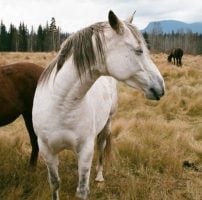
The Captain
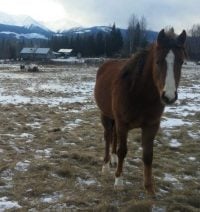
The Matriarch

The Teacher

Observation Number 2: It Rarely Comes to Blows
And aggression? When there isn’t direct competition for limited resources (a pile of hay, a treat, or a human with only two hands with which to scratch), I see none. Besides play, there is no reason to bear arms or raise voices. Why would there be? Maybe it’s because they have ample time not in competition that allows me to see them so peaceful, and to consider that the norm.
Observation Number 3: Nothing is As It Seems
And at other times, I see each of them take their turn to initiate movement, move each other off food, make decisions regarding the whole herd, and defend against intruders. There is no consistency or pattern I can work out besides their own personalities and interests that lead to common behaviours. There is no hierarchy to speak of – at least not a linear or predictable one. They each have authority over their own person, and express that in their own ways.
Observation Number 4: The Love Quadrangle
Another behaviour ethologists point to is pair bonding. Pair bonding manifests as two horses with a strong preference for each other out of an entire herd (or a deep connection between a small herd of two). They exhibit this bond by mutual grooming exclusively with their buddy, sticking close while grazing or moving around, and often sharing food. Many people suggest keeping herd numbers even for this very reason – an odd horse out could be a lonely one.
I used to think this was a given, having noticed it in most domestic herds. Lucy Rees reports that the wild herd she observes does not exhibit pair bonding – that outside of mares and stallions bonding in a natural herd setting, it is an artificial or domestic behaviour born out of extreme stress and trauma.
My horses have been through all kinds of stress and trauma due to the realities of domestication, so it stands to reason that they’d bond up this way. I was just trying to mentally pair my horses off the other day when I realized that I couldn’t – I have, I realised, instead witnessed every possible permutation of horse-buddies, and each relationship is as unique as it is strong.
Firefly and Falcon are besties and possibly going steady; they often wander off together to smooch in the bushes or stand close together with their heads over withers. But Firefly also needs her momma, and she and Amalia spend hours each day nursing and getting their girl-time in.
Spero and Firefly love to share a pile of hay, or learn new games with the humans together and bicker over whose turn it is to get the treat. Spero loves having Falcon around to wrestle and have manly conversations with, and Amalia and Spero like to hang back together when the kids wander off. They’ve known each other the longest, and while they often feel like oil and water to me, there is something undeniable about their connection. Falcon and Amalia aren’t seen together that often…unless Amalia’s in heat! Then she’s all about that sweet young thing…
And of course this is entirely anecdotal, and I’m projecting a bit for the sake of a story. But the behaviours are what I witness day after day, as I’m able to peek at them at any time without getting myself too far into their dynamic and changing it.
What You (Want to) See is What You Get
Why is this so fascinating to me? I think because we have created some well-worn grooves in our assumptions about herd dynamics and horse psychology. If you want to see something, after all, it’s pretty likely that you’ll see it – regardless of what else might be at play. Theories, after all, give us possible justifications or new directions for our own behaviour and, in this case, our relationships with our horses.
Dominance theory (“Horses are violent/oppressive/hierarchical! You can be too.”) gives us permission to dominate through physical or psychological means. It has led to some abusive methods, as well as some bizarre ones, and some that are arguably practical, even necessary, for safety and survival in a human-determined world.
Leadership theory (“Every horse is looking for a leader. You’d better be it.”) softens that approach and adds some fabulous insights, but essentially perpetuates the idea that horses should do as we say all or most of the time. Approaches vary wildly, from psychologically abusive to super-chill and loving, which increases my suspicion that there isn’t, in fact, a universal archetype for an equine leader that we can all refer to. It makes for a giant grey area for people trying to create a healthy relationship between themselves and their horses.
The lesser known phenomenon of pair bonding (“My horse is my partner/best friend”) is, as a basis for relationship, again a giant leap forward – but does allow us to take advantage of (and/or misread) our horses’ deep need for companionship and collaboration (which they may be missing in their artificial herds or isolation), by inserting ourselves as their one-and-only, despite only being in their lives an hour or two a day.
None of this is wrong, in and of itself! But it could be that these ideas are only little bits of a much, much bigger picture.
I’m admittedly somewhat of a leftist socialist collectivist tree-hugging idealist, so maybe that’s why I’m observing my guys defying convention. It certainly gives me permission to continue as I am – leaving them largely to their own devices, joining in when possible or appropriate, exploring and following their lead as much as I am offering and inviting them to follow mine, and making sure they have most of what they need whether or not I’m there to provide it daily. I’m probably missing some really important bits, too – and I’m sure I’ll write about them when I inevitably stumble across more of my own mistakes and blind spots!
Educate Me!
I’d love to hear about what dynamics you’ve observed in your horses or herds you’ve known in the comments below. Can you think of reasons for these behaviours? Do they affect how you interact with your horses? Have you rejected (or adopted) any theories that have shaped the way you work or live with horses? Children? Dogs? Goldfish?? I wanna know!
***************************
Oh! And I almost forgot – drum roll please….my full length album will be available on CD and digital download July 15! It’s called Looking For Horses and, though not exactly horse-themed, is undeniably horse-influenced. It follows my songwriting over the course of 10 years – from first love to dark times and big realizations, the idealism of my younger years and the persistent call to wildness. Always, always, horses have been there to guide, define, support, and witness my winding path.
Head on over to our shop page to pre-order the album with a heartfelt discount for you incredible horse listeners 🙂
Click here for Part 12 in this series.
A barefoot hoof trimmer, a singer/songwriter, an amateur farmer – these are some of the hats Kesia Nagata wears when she’s not full to bursting with wondrous equine co-creation.

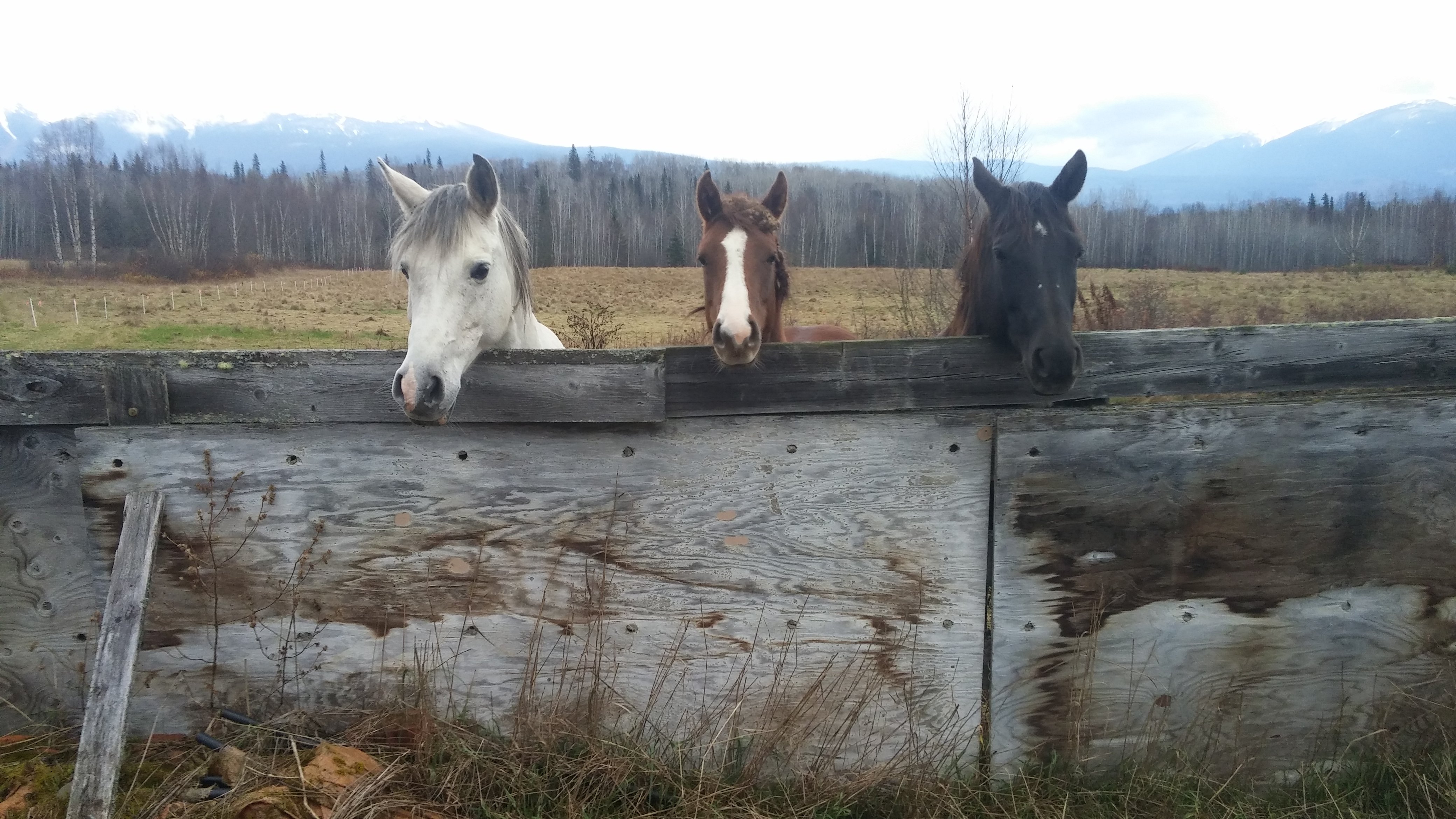
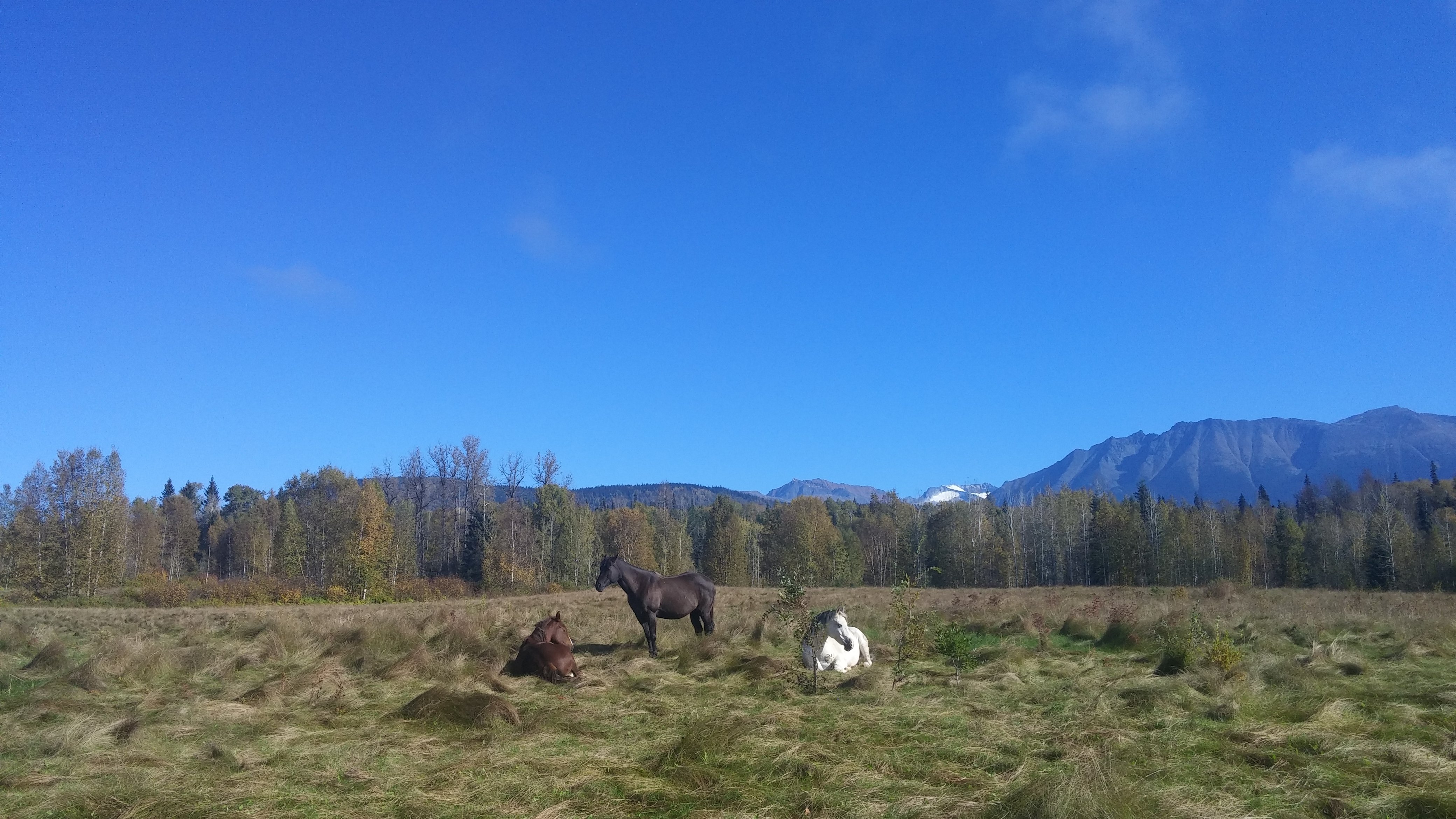
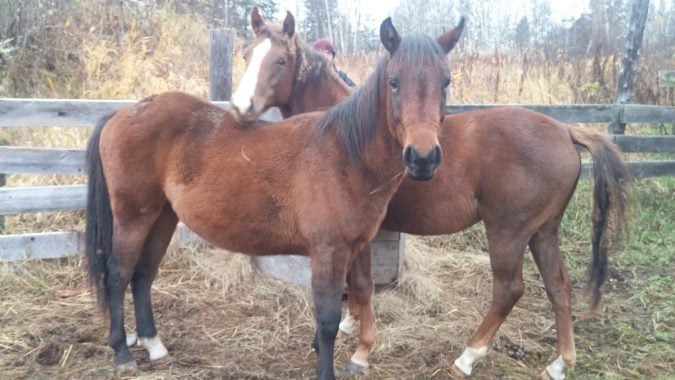





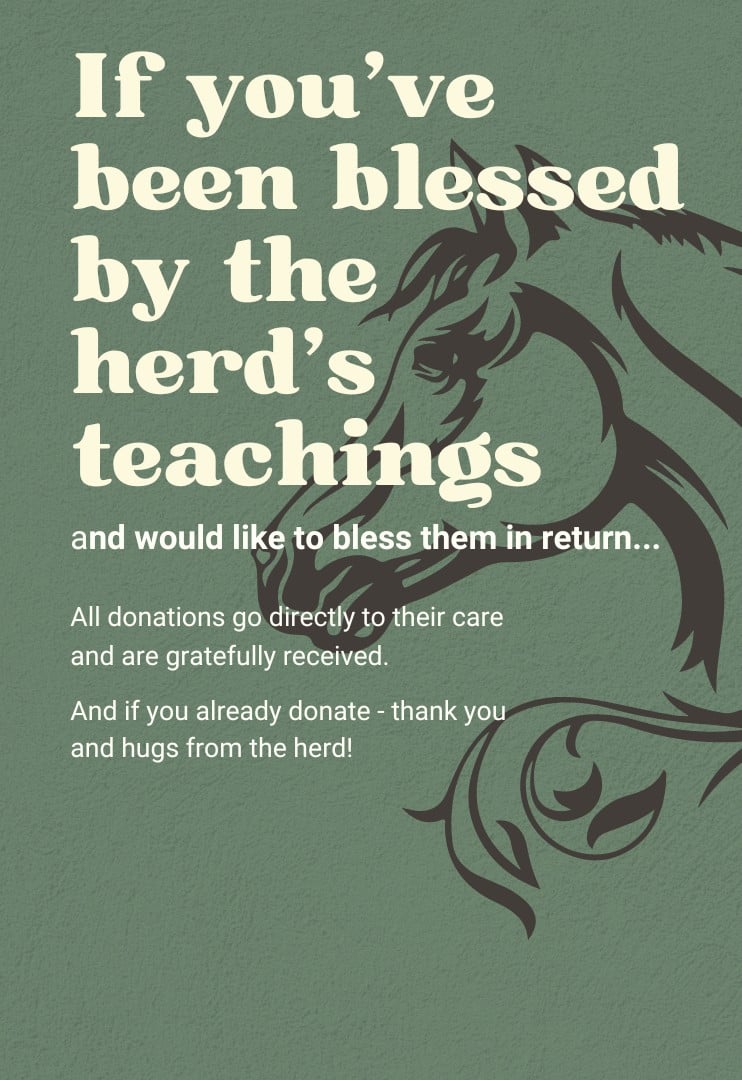
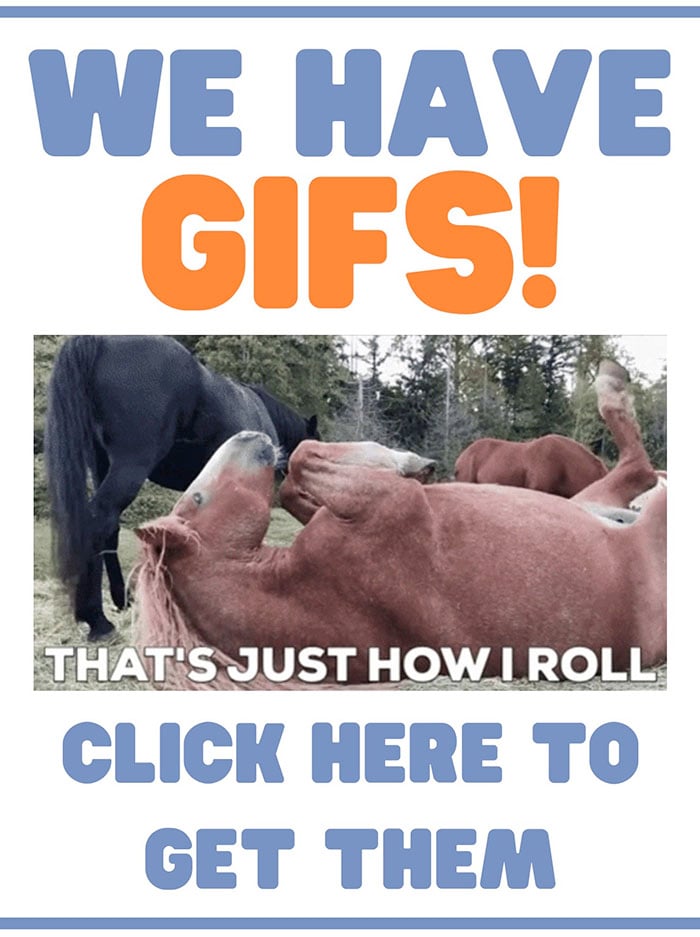
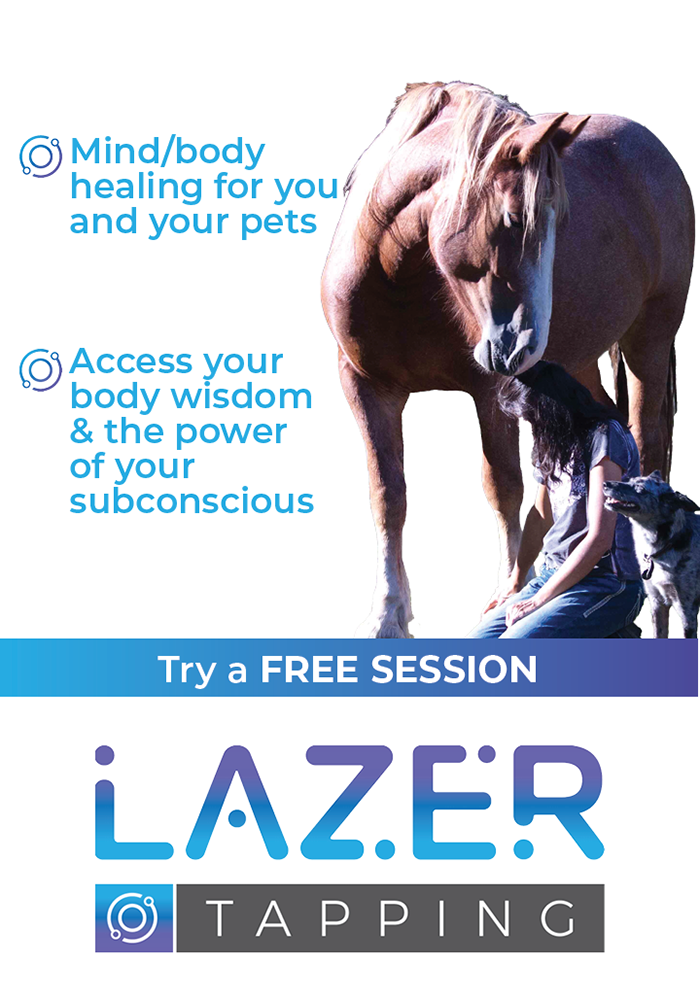
Kesia….I to have watched Lucy Rees. I thought it was super interesting how she observed horses and came to a lot of conclusions that were new and very insightful. I have also watched the PBS Cloud series documentaries and thought they were so extremely interesting. I feel you have pretty much nailed it in your observations too. My herd of only 3…hopefully to be 4 soon…is just like yours with each of my horses having different roles at different times. As I have shared with you I am on 12 acres and with all this fabulous California rain this year I have not had to feed hay for almost 6 months now. I feel like this really helps things flow and resemble a little more of a “natural dynamic” (there’s that natural word again..lol) My very strong but lame paint horse Banner is the top dog when like you said treats or special human food or scratches are involved…but he will almost always listen to me when I ask him to share and not be to bossy/pushy when I am involved. He can move the others very easily and is the herd worrier and gets very vocal when they other two are not in his vision. I feel when I am involved he gets a sense of peace/relief that he can relax and let me handle the other two for him.Bullet is the class clown and loves to do his own thing he can leave the other two without any hesitation and loves to come seek me out for his alone time with me and his new passion Liberty fun…I bought him a horse ball for his birthday and he is really starting to have some fun with it. He also is the big napper and loves his sleep. Dreamer is my new guy that I got last August and he is a mover. He keeps everyone exploring every inch of the property and loves to watch the world go buy. He is also extremely sensitive to other horses well being and would not leave my neighbors two mini horses when they were foundering in December. He made sure he conveyed to me that I better fix them(which luckily I was able to help with) He hung out next to them until they were on the mend. I would have to go get him to make sure he drank and get him to eat his special dinner bucket with all his goodies(minerals,probiotics,herbs). His sensitivity and concern for other horses in the neighborhood is inspiring and something I personally have never witnessed. He is extremely social a big opposite of myself. I have also witnessed them changing the pair bonds so that the three of them trade off with mutual grooming and kanoodeling. I have even seen a mutual threesome grooming on occasion. I think just like with humans we all have our strengths and weaknesses. We also can all have good and bad days. I don’t feel like one of my horses dictates the flow at all times ….it just seems to happen so easily as they all come and go from each other as the day moves them. I definitely feel like us humans have way to much of a negative impact on our domesticated horses, in most situations and like you said we just throw them together and expect them to be a family, or even worse in my opinion we isolate them in small enclosures. What human could stay locked in there closet or bathroom for the majority or all of the day without having it take a negative toll on them? But like the saying goes it is what it is and all we can do is be aware and take up & engage in whatever kind of relationship that feels right between ourselves and our horses on any given moment or day. I love and appreciate my horses so much they change me a bit everyday and they teach like no other I have ever come across. I am truly a happier hopefully better human because they are in my life. I try not to set anything in stone especially the majority of human perceptions, of what is suppose to be the way we interact with them. I am so grateful I am a strong headed women who marches to the beat of my own drum (earthy, tree hugging, Mother Earth loving, animal junkie) and now tries to do as your blog so beautifully tells it LISTEN TO THE HORSE. ✌?️❤️?
The herd
So sweet to read, your descriptions of your horse-babies 🙂 I can totally feel them here. I love love love the image of Dreamer looking after his mini buddies. What a compassionate guy. I mean, we can get all sciency, which is fun, but like you’re saying, they’re just people. Horse people. And it still amazes me that people aren’t able to recognize this – that, like us, their cultures and social patterns are reflective of their experiences environments, and if given the chance they are all so different and quirky.
I also like to think that, like them, we might be better at being together if we removed some of the constant stress we keep our nervous systems in. While most of us in the first world have enough food and privilege to not worry about survival, our poor little bodies are in constant fight or flight due to the endless exposure we have to toxins, fears, and concepts that are actually beyond our animal selves. I woke up this morning worrying about god knows what, amazing myself at how much stress was building up in my body and mind. Yikes. Time to go moon around with the herd.
Keep on shining, girl! You are a delight.
I witnessed a herd who are largely left to their own devices outside of the occasional ride, supplemental feed as needed, and regular health care. The relationships were very fluid, though one particular mare sometimes seemed better able to connect with (some, trusted) humans than her herd mates. They displayed behaviour very much like what you’re describing, including a mature gelding who still occasionally nursed, as well as fluid pairing and leading. They roamed 40-300 acres and enjoyed hanging out with humans.
Huh! So cool. I mean, writing that article it occurred to me that it just seems normal to me – why wouldn’t a horse herd be a network of unique relationships? I love the word fluid to describe what you observed…
Totally! I sometimes forget that it’s NOT normal til people come here and are blown away by the peacefulness of the herd and the amount of freedom they have. It’s my aim to make this way of being for horses the norm. They soo deserve it. Living with free choice is after all just their basic right.
I see parallels in the dog world where transition is taking place from a dominance, control model to a more respectful, considered view. Suzanne Clothier’s Bones Would Rain From the Sky offers a beautiful perspective (substitute horse for dog and it’s all applicable) and is a great exploration of how (and who) we can BE with animals while helping and teaching them to navigate in a human managed world.
Adding it to the mental book list 🙂
I was just totally shocked by an acquaintance’s treatment of her little puppy – I’d forgotten that some people still do the whole freak-out-slam-the-dog-around-I-am-the-alpha thing. I feel like there was this time before everyone thought they were a trainer when dogs and horses had a little more leeway to be who they were – maybe humans were more ignorant, but it wasn’t expected that the animals’ every move would be controlled. Maybe I’m idealizing. I’m so glad that there is more movement toward considering the dog’s experience.
I have tons to learn about how to teach what they need to know – most days I’m amazed at how much they do for us without being taught (constantly suppressing instincts like jumping, biting, killing, etc, for the sake of our comfort and approval)…
It’s sadly very common in the dog world. Sigh.
So are unrealistic expectations.
Actual conversation: “My puppy won’t walk nicely on leash.” “How old is he?” “Eight weeks.” (1) “He’s still a BABY!!!! One, he barely gets what a leash is and two, you have to teach him HOW to do that, in time.”
My life can be summed up with:
“My dog won’t _________.” “Did you teach him to do ___________? No? Then how could he know?”
“I don’t like that my dog ________.” “Have you taught him anything you can have him do instead of _______? No? Well how could he know?”
On the bright side, I also work with people who say, “How do I teach my dog to ______?” That, keeps me going.
Yes! So basic, but it really does slip most people’s minds – that we can actually teach animals things. And that it’s not really fair to get mad at them for behaviour or lack of behaviour if they’ve never learned differently. But getting clear enough to teach effectively – or even to realize what can be or needs to be taught, and how to do so – is actually quite hard for most people. We spend most of our lives in unconscious competence, and unless we’ve learned how to translate into clear teaching, most of us are only moderately good to absolutely rubbish at it 🙂 That’s why we need you.
So here’s something interesting – those puppies I inundated FB and Instagram with, they stuck with their mom for 9-12 weeks. I know 8 is standard but 6 is very, very common. We got Beatrix at 7 weeks and she was really wild, needy, bitey, and didn’t understand what “no” could possibly mean. By contrast, her babies are all adjusting really quickly into their new homes, are just about all house trained, are learning commands like it ain’t no thang. They have this…nuanced awareness that I haven’t seen much before in dogs this young. It might be the breeding, but I noticed between 6-8 weeks, a crucial shift happened. They were weaned naturally, and their parents taught them under no uncertain terms what “no” was, as well as demonstrating what “sit” and “come” etc meant. I noticed their behaviour and attentiveness changed and they suddenly became more aware and intelligent. By the time they left, they were ready – I can’t describe it any better than that.
I have read about alpha theory in dogs evolving through observation of wolf packs – in Yellowstone Park where they were artificially selected for a conservation program! But in reality wolf packs, like horse herds, are actually families, less linear and more fluid in their dynamics. So. I just thought it was cool to watch my little dog family operate as a family-pack, and to see what a great effect that had on the pups.
In the UK the dog world has really shifted in awareness about dominance much more than the horse world. It gives me hope! But here people still mainly question why you’d have a horse if you don’t ride or “use” them for anything. How is that thinking l in the USA?
“What you want to see is what you get.”
Well observed.
Yep…I think this happens in science all the time. You’re supposed to start with a hypothesis but people are more likely to start with a conclusion, and work backward from there to prove it…
Yesss!!! Fabulous article so well observed, thank you Kesia! We have a herd of seven here, and since moving 5 months ago they have been absolutely as you’ve observed.. Very much a mixed, peaceful herd with shared and mixed responsibilities and attachments. The only thing that ever upsets that is human intervention – and only then when we are not listening to them properly. They are unridden, they do not get “used” for anything including fulfilling our human “needs” and they have released and healed into an unconditioned state. We’re able to observe them from our house without changing the dynamic and interacting with them.. It’s fascinating and such a privilege.
This sounds so similar/familiar to me! Can I ask what their situation was like before you moved there, and what changes you’ve noticed? Or have they always been this way together?
Also this: “released and healed into an unconditioned state” is my new favourite sentence. The sentiment and the perfect way you’ve expressed it – gold!
Hi Kesia, Thank you 🙂 Yes, I love that concept and sentence too! You ask what their situation was like before we moved here… I’m afraid I can’t answer that briefly so apologise for the long reply!! I’ll try my best to keep it brief!
No, they haven’t always been this way at all. They’ve all been through a HUGE journey – as have I.
Last April (2016) our 18 year old tb mare Missy lost her close companion, our beautiful boy Eddie who passed incredibly suddenly from a bout of very severe colic. It was devastating. Prior to bonding with Eddie, Missy had spent much time hanging out right on the edge of the herd and being very introverted. She’d come from a race background, injured herself so was unable to race, was sent to stud repeatedly and “raped” (as she has shown me graphically in a very healing and releasing communication), was deemed barren so was then turned out with other horses who were all deemed “useless” and eventually put to sleep. So she lost everyone she had bonded with. She was due to be next to be pts when I met and rescued her. During Missy and Eddie’s 3 years together she learned connection and trust with horses again – the day they first mutual groomed will live in my heart forever. She also gained trust with humans for the first time ever – through me being in a state of mindfulness, using grounded communication, offering healing and asking nothing whatsoever from her, we have come a very long way together. She has been my greatest teacher through the past 5 years of being together.
After Eddie sadly passed over last March, I quickly needed to find a companion for Missy, so 3 year old Blue came to live with us as a rescue from a hugely traumatic incident. She was terrified of people and wouldn’t come near anyone. Using the gentle ways of mindfulness, communication, healing and no expectations, Blue completely gained trust with me in just 6 weeks which was such a huge privilege. Her young, loving energy pulled Missy out of herself and they quickly bonded.
A few months later a friend urgently needed a home for her herd of 4 rescue horses, so I offered to help, and so all 6 then moved to our new place last November.
It was amazing to see Missy change overnight from being the most submissive horse in the herd, into the wise and strong being that she is today. She is often right in the middle of the herd and rarely takes herself off on her own now days.
In January we rescued a 9 month old colt who had been dumped on the roadside having literally just been weened. It was incredibly heart-warming to watch Blue take him under her care and teach him socialisation skills so that he could then after a few weeks be accepted into with the whole herd and be relaxed, playful and sociable. Again, with me using a gentle way of being, it has helped him to release his aggression and confusion and be a peaceful member of the herd.
I believe two major things have made the most difference to them being able to be in this unconditioned state. First – the fact that they really trust that there will be no requests made of them that are not for their highest possible good. We are very clear with our intention that they have a choice. This even includes choice in when they are touched. The majority of time that animals are touched by humans is as cuddling / stroking to fulfil a need in the human. By recognising this and listening to the very subtle yes and no that animals communicate with, they can begin to truly feel heard. Secondly – they have free access to a large acreage where they have plenty of enrichment. They can choose to be in woodland, in large open grassland, under huge trees, in barns with bedding, in hedge sheltered areas, with plenty of access to great quality hay, fresh clean water, no rich grass, lots of medicinal plants & herbs to self select from, free draining soil, not stabled, confined, shod or rugged, and with their natural horse needs adequately met.
Jacqui your place sounds amazing – can you upload some pics for us, so we can see your set-up?
It’s beautiful here, and very unusual for the UK to offer horses 24/7 turnout with various types of shelter, not just a square paddock, not rye grass or lush grass of any kind and so much enrichment. I used to dream of the massive hundreds of acres of prairie land you have available in the states though! Question- why do you say your horses have “between 50-200 acres”?
Some pics of our place as requested Kesia x
Would love to see your place too. It sounds fabulous.
Beautiful! Where in the UK are you?? It must be hard to get larger acreages there…
I say 20-500 acres because we have 500+, but it’s not all fenced, and much of it is bush. For the winter they have been in the front 20 as they kept taking off to eat the neighbour’s lawn when they had total free range. They have shown me 20 is fine – but they do love adventuring out back when we’re together, and EVENTUALLY should have most of the place for their own devices
Just tossing in a couple thoughts, hopefully not anthropomorphizing too much. My mare, Sadie, was born into the herd she lived with in rural Missouri until she was 6. At that time, my husband and I bought her and her half sister, both having the same mother and being a year apart in age. We put them in a boarding situation, which didn’t go well at all. Sadie was apparently very stressed and wouldn’t let any other horses near her younger sister Magic. So they were separated, and Sadie was traumatized. She started shadowing a horse, seemingly for safety, but would hold off the entire herd at the gate before feeding. She would stand at the gate with her head hanging low between a shed and fencepost for hours. When I would take her out, she would refuse and pull back when I had to return her to that paddock. I won’t go into all the details of her behavior here, but it was perplexing and obvious she was depressed, angry, and in survival mode. It was also extremely distressing for me. We quickly moved to a wonderful board setting and things were much better, with lots of space, food, small mixed herds. Yet Sadie again took a long time to “settle” and become more relaxed. After more than two years of peace, some horses left, and several new horses were put into the herds. Sadie started to appear quite nervous, always struggling to feel safe and “not bottom”. She was bitten a lot and kicked in the vulva, leaving a significant gash, which healed completely. Herd makeup was rotated and she remained nervous and jumpy, with some fear aggression behavior. Finally she was placed back into the herd with the horse who injured her, and she became overtly aggressive by kicking, defending food, and keeping herd members at bay, except for her sister. She was put alone for a while, and now fast forward to her being in with her favorite gelding’s herd this spring. She had always bonded with this gelding, following him around like a shadow. She has an affectionate relationship with him, but it appears she might feel secure with him, eating with him and rarely being anywhere but at his side. She is a tiny horse and the other herd members are quite large…
The interesting part is a new relationship she entered when a new mare was put in the herd, and became the quiet but dominant leader. The gelding friend and another dominant mare (#2) have teamed up to challenge her but she holds both of them off. The #2 mare has always driven Sadie off or been obstructive, but now this new mare is very protective of her. For example, if Sadie is not allowed to walk past mare #2 in order to get to food or her gelding friend, the lead mare will approach Sadie, they will exchange breath, and the lead mare will stand in front of the #2 mare so Sadie can scootch through. And when the #2 mare goes out of her way to chase Sadie, the lead mare will go over there and chase the #2 mare away. I have assumed this is just the lead mare keeping peace and providing safety for all members. But yesterday when I took Sadie out of the herd to ride in the arena, I noticed the lead mare left the herd to come to the arena door and watch our ride, and she usually meets us at the gate when Sadie goes back into the herd. Now I am thinking that they have a special bond…Sadie has told an animal communicator that she misses her mother, and the lead mare is a brood mare whose weaned foal is no longer with her. So another dimension beyond herd dynamics might be in play here, in which two individuals might be filling each others’ emotional needs. In any event, the mare seems protective of Sadie, and Sadie seems to communicate with her in a way I have never seen before…standing head to head, nostril to nostril. Whatever it means, I am grateful that Sadie is learning to trust and communicate with this mare. Before this, she was kind of a misfit. I think it took her a long time to get used to the boarding environment and to learn to relate to horses who are not part of her birth family. I may be jumping to conclusions here about a lot of things, but it is so interesting to continue watching the interactions, behaviors, and heartwarming to see Sadie a little more settled. She seems to feel more a part of the herd now and doesn’t appear so fearful. Now, regarding comments…you are free to disagree, but please be kind, objective, and not angry…I’m just offering this up as a story of interest. Thanks!
Such a fascinating story, D! It doesn’t sound like you are anthropomorphising to me, at all – these sound like the observations of someone acutely aware and open to the consciousness of your horses.
I am especially moved by the fact that Sadie is changing and developing, through the love of her new friend and the rest of her herd, and no doubt from all kinds of help you have given her that you aren’t telling us about. Your efforts to find her a situation that works for her are so commendable. Look what she’s been able to experience!
I’m guessing you didn’t know her much before you bought her? Do you have any ideas as to what initially rocked her trust in the world? She sounds like a very sensitive and soulful lady…
Thank you so much for sharing this. I think the more we can talk openly about our observations, the more normalized these things (which are actually quite normal if you assume sentience) can become, and the more we can learn, and the more our horses can benefit.
Thank you for your comments and questions, Kesia.
Yes, Sadie has a wonderful, sweet heart. From bits and pieces of information, I know she was an extremely friendly and affectionate foal. Her mother did not feed her much, and I have a picture of her kept in a paddock by herself as a young foal, trying to stand next to a 2 year old “auntie” mare with a fence between them. Because of her insecure social behavior, I assume she was deprived of opportunities to learn from a herd environment during the important developmental time. This is why I am so heartened to see her learn to communicate with her new lead mare friend. It has been wonderful to see her more confident, mixing more freely with the herd members, eating in close proximity with them, and looking like she feels she belongs.
Just goes to show it never has to be too late ❤ My mother works in trauma therapy – working with the nervous system. I especially love knowing that the nervous system can be rebuilt or reconnected where it isn’t strong or well developed. That what we don’t get as a baby might be possible to fulfil later in life, that those pathways or lessons can be ignited and the being can feel more whole and resilient… Yep, I love it.
Go Sadie!
Dear Kesia,
Thank you, thank you for continuing your series on your rewilding project. i really enjoyed your telesummit talk and it’s great to hear the progression of the story and your exploration! As usual, the comments here are equally rich. I’m so interested in what Michelle shared too about her herd. So many ideas and stories are coming up for me as I read your post and the comment thread.
I’ve been living with a herd for almost 2 years now and everyday realize how little I know about herd dynamics, even after spending almost my entire life of 52 years with horses. That’s pretty sad in a way but I grew up with them exchanging mucking stalls for riding whatever horse I could, the race horse industry, the horse show industry … all our ‘constructions’ of horse interactions. And I learned a lot from these experiences, horses gave me a lot. But really nothing about what it means for them to be able to work together as a herd.
When I gathered the herd I now live with, even though I had no idea of what would emerge through the herd, I had purchased the farm (500 miles away) and was preparing to move within about 4 months. I had a beautiful black mare companion, Echo, who my daughter and I had bonded with for over 8 years and who had been my only real partner in supporting Lia, my daughter, with her epilepsy.
It was Echo who led me in some very mysterious ways to explore EFL, create a vision, buy the farm and begin to gather a herd even before we moved (I started to bring them one by one to the boarder barn we were still at). Each time I would go to see a potential horse to join us (visiting rescue farms), I would talk to them about Echo, give them images of the farm and talk to them about our work together with people. The process was pretty amazing. In some cases I would be heading out into a herd of 60+ rescue horses and not knowing where to start – they all looked beautiful. But one by one, as I followed my intuition, my connections with various horses, told them the story and saw how they responded, we selected each other. In one case, a gentle small mare who was nervously pacing and anxious suddenly came over to me, very quietly listened to my story and then followed me to the gate and waited there for me for over an hour while I finished a farm tour. I had to clarify for her that she wasn’t coming today but I would be back. In another case a stallion, about to be gelded at 19yrs drew me in and returned again and again in my dreams. The farm owner, who had been very adament that he wouldn’t be up for adoption until at least 6 months after his gelding, called me 4 weeks later to say she felt very strongly he should go with me. As it turns out when we made the 500 mile trip to move to the farm, I would later learn that the now gelding was returning to his birthplace and the new farrier I found was actually his former farrier! In another case, I was drawn to a large mare because I felt a strong kinship with the sorrow I felt when standing with her. As it turns out, after moving to our farm, she had seizures – several different types and all 3 very similar to the ones my daughter has. This mare has given me a whole new perspective on seizures that no human could have done.
Over the course of the two years coming here with the herd, one horse has died, another adult rescue arrived (which the herd had a hand in selecting) and a young filly has also arrived (this one, as strange as it sounds, totally orchestrated by the herd).
Over the two years they have worked a lot to come together as a herd. Echo has always been very welcoming, grounded and easy to get along with most other horses, but she had never in her 11 years of life, been out all night let alone lived 24/7 outside (I’m talking ridiculously the opposite of that where we had untold numbers of blankets for every 10 degree window of weather!! i cringe and laugh now).
They’ve had a lot to adjust to energetically in forming the herd and then adapting it with the death of one member and the arrival of two others. And they’ve shown me things .. like how important it is that I put out their hay in flakes all over the property so they can walk and graze in movement together. One night they gave me a vision of how this is actually central to how they balance and move the energy of the herd. They taught me a bit (only a bit because I know i’m pretty dense getting their lessons!) about how they shift the energy of the herd when one member leaves to account for that change and how they adjust it again when a new member arrives. They’ve shown me a lot about how they work together, particularly with Pearl, the baby (I have some pretty crazy stories of how the whole herd pitched in to help the vet check her over at liberty in the field, and how they support her in learning how to get her feet done). One of the herd experienced what appeared to be like flashbacks of trauma after Pearl arrived and after the first incident which caught us all off guard, the herd quickly learned how to support him in processing the trauma (and the best way for me to participate by actively holding space out with them). Twice we have had health incidents that took a herd member to the brink of death (a badly twisted colon and a heart attack) and both times the herd and the horse affected took me with them to the precipice of life and death, stayed there with me showing me what it can be like to hover in that moment without fear, with only love, and then, despite no apparent medical explanation, they have ‘come back’ to life.
When I did my EFL certification (I took the FEEL program), I learned a lot including certain exercises we do with clients (in FEEL the horse is always the teacher and at liberty). As my herd developed, they showed me how they wanted to work – which of course was nothing like the way I learned!) – and they would come up with new exercises, which they would show to me.
All this is to say that I am completely humbled by their insight and their desire to learn and grow together. I don’t see my herd having a ‘leader’ per se or any sort of hierarchy for that matter but they do all contribute uniquely to the herd and nurture the herd together first and foremost. In fact, one of the other key things they’ve shown me is that herd always comes first, when it is balanced and ‘whole’, then their individual talents and personalities shine. This is very different of course from our Western culture where individuality is primary.
This makes me wonder, how can we humans, with this underlying perspective of ‘individual primacy’, possibly think we can research and propose a theory on how something as sophisticated as the honed herd dynamics of horses work? I also wonder, is it possible that horse consciousness is evolving, and just like different cultures and communities of people across the globe, different herds are operating with different degrees of complexity in consciousness? This is NOT to try and assert that one degree or complexity is better or more valuable than another. It’s just to wonder, maybe the ‘answers’ to what is true for herd dynamics don’t lie with any one particular herd – wild or otherwise.
The only thing I feel reasonably certain of at this point, is that the horses have a lot to teach us and there is likely far more going on than I and most other humans can even comprehend. And even in the face of this, we must try! Which is why I love your writing and your music so much 🙂
oh my lord Tina… where do I start?? This. Is. Amazing. And I guess my next thought is: Where is your book??
Seriously, I would LOVE to read a book by you, where you give all the tiny details about each piece you wrote about here. If you told the complete, full, interwoven stories of every point you touched on in this comment, that would be an entire book and I would LOVE LOVE LOVE to read it!! Any plans for that?
Just, everything you wrote about here: YES!! And so cool! And I SO want to read more…
Jini just said what I was going to – I actually put off replying because I wanted to think more about what your wrote! The gist of it was: wow.
I want to hear more too, and we have another reader struggling with epilepsy in her horse – could I possibly put her in touch with you? She emailed me about it and sadly I had nothing much to offer in terms of know-how or wisdom.
“…how can we humans, with this underlying perspective of ‘individual primacy’, possibly think we can research and propose a theory on how something as sophisticated as the honed herd dynamics of horses work?”
ExACTly! It just seems so hilariously naive that we think we can – and also really makes me wonder about just about every other species humans have studied. I also think that it is more predictable what an animal will do under severe stress (many domestic situations) than what it will do when relaxed and content – thereby creating theories based on, essentially, false data, or research that isn’t reflective of the complexity you speak of.
As for evolution – of course! Given how much they have been exposed to as a result of their connection with humans, it makes perfect sense to me that they would evolve or adapt just as we have – to stress and scarcity, to safety and abundance, to the individuals that make up each herd, to their unique environments. I have read that there is different behaviour in almost every feral herd. Some herds are militantly hierarchical, probably due to living in extreme environments. Others are more modern – mares do not necessarily stay with stallions except to breed, and tend to pick different stallions based on their own preferences. Others still are deeply harmonious and tight-knit families…it goes on and on, and can be partly attributed to environment and resources (as can individual human cultures, I believe). It’s so interesting…and also so obvious when you stop to think about it…
Yes, good point! Why should there be a single type of “herd” or herd behaviour?? Is there a single group, family, or culture of humans where all other groups, families, cultures function exactly the same way – with exactly the same dynamics, same relationship constellations, same etiquette? It’s actually ludicrous when we think of it this way and yet every nature program, scientist, etc bases their story around how ‘this species’ works. It’s so pervasive, I never even thought of it before! Wow. This is a serious perspective shift… thanks gals!
Right?! Plain as day but so easy to overlook due to our own conditioning. I’d actually forgotten about this, the different cultures in different herds of horses thing!! And now I remember my original anvil-on-head moment…gotta remember which book it was in…
Your post really struck a chord with me…
We boarded our horses at nice barns for decades. Even though I thought the places we boarded at took very good care of our horses, I had formed the impression that horses are an accident waiting to happen. And I had labeled one or two of our horses as “Drama Queens.” Also being able to catch my horse in his stall to ride gave me a false impression of how strong our rapport was.
Then, 10 years ago, my husband and I moved to our own acreage. And now, although we still ride and do lots of things with our horses, they are living rough. LOL
Now that I can see our herd in an environment that is more “natural”, I can’t believe how chilled-out and easy-to-keep they all are. We didn’t have many problems before, and we thought our horses seemed happy. So I didn’t realize how stressed our horses actually were in the usual “grain, hay, stalls, and shoes, with daily turn out in single-sex groups, shows on Sunday” routine. *And I want to say again that I think very highly of the people – our friends – who run those boarding barns. They love horses, work long hours, and bend over backwards to care for the horses in their charge (and it is a lot of work booting, blanketing, etc. etc. the usual boarded horse.)
But I honestly feel you don’t really know horses until you can experience a herd in this more “wild-like” state. It’s been a joy, and humbling, to get to know our horses all over again. It’s like our horses weren’t acting like *horses* when they were boarded; they were washed-out horse-ish animals compared to their full-color, flourishing selves now.
On the one hand, because horses are so incredibly forgiving, humans get away with doing a lot of stupid things when they can use tools like stalls, cross-ties, confinement, isolation, round corals, etc. Go figure, it turns out that getting hoof care or vaccinations done harmoniously with 10 horses in a 50 acre field requires a greater level of finesse.
On the other hand, so many training and health care strategies are actually strategies for dealing with behaviors that aren’t really horse behavior. Go figure, it turns out that when you stop stressing out your horse, those undesirable things just stop happening. I’ve got loads of “training equipment” and “training techniques” that I’m never going to need again. 😉
This is all so great… Your compassion and respect for the folks you once boarded with stands out to me – it’s so easy to write such things off when we learn something new or feel we’re above or beyond our past selves. We’re probably really condemning our past selves when we do that…
But yes, what a big and fun and breathtaking transition and learning opportunity! I bet your horses feel that even more acutely. To be given back their bodies and culture…
I also had my first two horses stabled at the beginning, due to circumstance. My feelings were not as compassionate as yours towards my fellow boarders after I “saw the light” – both Amalia and Spero showed me right away how desperate they were to be free and as a 17 year old horse newbie I was actually laughed at by the more experienced ladies when I said as much.
This is so true: “Go figure, it turns out that when you stop stressing out your horse, those undesirable things just stop happening” …and it all seems so obvious in retrospect. My eyes still bug out a little when people label “bad” behaviour as anything other than what it is – fear, anger, pain or frustration… Oh well, I still have as much to learn as they do (it’s infinite!). And I’m looking forward to it all.
“It’s been a joy, and humbling, to get to know our horses all over again. It’s like our horses weren’t acting like *horses* when they were boarded; they were washed-out horse-ish animals compared to their full-color, flourishing selves now” – beautifully said. And I hope more horse people (and horses) get to experience that joy!
All the best to you and your herd.
I just LOVE this comment – ALL of it. Thanks so much for sharing with us!